
146_0803_18_z+2008_suzuki_b-King+andrew_trevitt.jpg
It was a pretty audacious move by a Japanese OEM. Even one with a long-established reputation for performance above all else.
When Suzuki unveiled the original B-King concept bike at the ’01 Tokyo Motor Show, all the rest of the interesting machinery displayed at the event faded into oblivion as far as the sportbike public was concerned. Concept bikes usually showcase wild and alternative ideas in motorcycle design, and while the B-King included its share of unorthodox visions of motorcycling’s future in its overall package, the centerpiece of the bike-the engine-is what captivated the public.
Instead of some biofuel or electric/hybrid powerplant, the B-King was basically good ol’ American big cubic horsepower overkill personified. Not only did the B-King use the 1298cc engine from the original Hayabusa, but it also had a crank-driven supercharger force-feeding the already beefy four-cylinder to the tune of a claimed 240 horsepower.
This led to a significant groundswell of public support to make the B-King a reality, so Suzuki tasked its engineers with bringing the concept into the real world. Of course, building a blue-sky concept bike and building an actual production machine for public consumption are two completely different jobs, and many production versions of previous concept machines have ended up being completely watered-down reflections of the original. Suzuki didn’t want to fall into that trap and spent a considerable amount of time-seven years-trying to keep the production version as close to the original as possible.
King Of The Bs
The original B-King concept bike was conceived as Suzuki’s vision of the ultimate naked bike laden with high technology, performance and technical advances for sportbikes in the 21st century. The name represented the concept of becoming the king of the Bs: Boost (Pursuing ultimate engine power to boost the machine forward with tremendous acceleration performance), Block and Beauty (Pursuing the pleasure of watching and of being seen, with a distinct, robust beauty composed of blocks of carefully shaped components) and Brain (Pursuing a fascinating new man-machine interface with electronic features that let the machine more actively communicate its running condition to the rider).
The foundation for the boost portion of the concept was already laid with the Hayabusa engine, although the supercharger had to be jettisoned for the production model due to cost, emissions and power issues (despite being the company that gave birth to the Hayabusa, Suzuki management felt that the public wasn’t quite ready for a 240-horsepower naked bike just yet). The production B-King had the good fortune of undergoing final design at the same time as the new Hayabusa, so instead of being saddled with the old-generation engine in diluted form, the B-King comes with the exact same engine as the new ‘Busa; only the airbox and exhaust are different (more on that later).
The concept B-King’s styling was the other main aspect that really made it stand out from the rest. A menacing, powerful and bold overall look was the obvious theme, from the blocky front headlight to the huge fuel tank with its large intake scoops on either side that also housed the turn signals, to the monstrous underseat twin mufflers with their slash-cut megaphone design. Adding to the big-and-powerful motif were huge tires mounted on both ends: a 150/70-17 front and a 240/40-18 rear.
One look at the photo of the show concept bike reveals that Suzuki stylists have kept the production version’s overall appearance pretty darn close to the original. The majority of the former look is retained, from the squarish headlight to the huge side scoops on the fuel tank to the angular tailpiece with slash-cut mufflers. Unfortunately the monstrous tires had to be exchanged for slightly more conventional rubber in the name of realistic handling on the street, which actually ended up paying major dividends for the B-King’s handling characteristics (again, more on that later).
The concept B-King had a dizzying array of electronic features befitting the bike’s futuristic intentions. The instrument panel was built into a heads-up display on the helmet visor, with the ignition using fingerprint recognition instead of a key; there was also a sophisticated antitheft system for communication and tracking if the bike was loaded onto a truck.
Various self-diagnostic systems were present throughout, with Bluetooth technology allowing remote notification of scheduled maintenance, as well as a GPS-based weather warning system to alert the rider of bad conditions ahead. There were no rearview mirrors; a closed-circuit TV camera transmitted its rear view to a small LCD monitor mounted near the dash.
While the concept of all this electronic gadgetry is nice, Suzuki engineers thankfully recognized that futuristic systems like those fitted to the show concept bike aren’t very practical in real-world use without further refinement. Thus none of the concept bike’s brain functions made it to the production B-King.
The Sum Of All Gears
As previously mentioned, the B-King and new Hayabusa were developed at the same time, so the B-King gets the same new-generation 1340cc powerplant as the Hayabusa. No parts-bin refugees here; all the upgrades found in the ’08 Hayabusa engine are present in the B-King mill as well. Besides the increased displacement, these include the titanium valves, new 12.5:1-compression pistons, redesigned connecting rods, revised crankshaft and 44mm SDTV dual-throttle-valve throttle bodies.
For more details check the Hayabusa First Ride in the Feb. ’08 issue.
Instead of the ‘Busa’s twin upswept exhaust system, the B-King follows the concept bike styling with a 4-into-2-into-1-into-2 system with Suzuki’s SET valve and twin underseat mufflers. An O2 sensor and several catalyzers ensure meeting strict EPA and Euro III emissions standards.
Rather than trying to adapt to the ‘Busa’s chassis, the B-King uses an all-new frame and swingarm designed with the naked bike’s different riding intentions in mind. The frame is made using the same latest casting methods that allow varying thicknesses in different sections of the casting for optimum rigidity balance, along with permitting fewer sections in the final assembly. The beautifully cast swingarm also uses the same precision die-casting method to achieve similar benefits.
The B-King’s different fuel tank and chassis requirements forced an airbox redesign, with the B-King’s airbox volume slightly smaller at 8970cc than the Hayabusa’s 10,300cc. Steering geometry is a bit relaxed from the ‘Busa, with rake extended to 25.5 degrees (from 24.2 degrees) and trail lengthened to 107mm/4.2 inches (from 98mm/3.9 inches); wheelbase is also 1.5 inches longer than the ‘Busa at 60 inches.
The 43mm KYB inverted fork was designed especially for the B-King, and it-along with the KYB single rear shock-offers full adjustability of spring preload, rebound and compression damping. There’s also a reservoir-equipped steering damper positioned just behind the steering head to quell headshake. Braking is handled by radial-mount Nissin calipers with offset-size pistons gripping 310mm discs up front, with a single 260mm disc/single-piston caliper combination out back.
And although Suzuki couldn’t fit the concept bike’s original massive tire setup, it came close: While the front tire is the usual 120/70-17, the rear is a fat 200/50-17 size. Thankfully, Suzuki also saw fit to have OE-spec versions of Dunlop’s superb Sportmax Qualifier as stock tire fitment.
You Can B-King
Suzuki didn’t make any effort to hide the B-King’s hefty build, and sitting on it only reinforces the fact that you’re not astride some scrawny poseur bike. Although the reach to the handlebar is fairly short and the wide, flat seat provides good support with decent legroom, the B-King’s midsection is pretty wide between the rider’s knees. Accentuating the sensation of size is the top of the fuel tank, which splays out considerably due to the added width of the fake air scoops on each side (unfortunately, despite outward appearances, the B-King does not have ram-air induction).
Spec-chart mavens will assume that the B-King’s relaxed steering geometry and additional wheelbase would make it much more ponderous than the ‘Busa-but nothing could be further from the truth. Once underway, the B-King’s hefty feel quickly disappears, replaced by a balanced, neutral-feeling chassis that is anything but cumbersome. While not exactly possessing the rapierlike agility of a middleweight sportbike, the B-King’s steering is surprisingly responsive and sharp, with barely moderate effort required to initiate a turn; the leverage provided by the handlebar (which is wider than the usual clip-on bars) and the quick-steering Dunlop Qualifiers surely help here.
Twisting the throttle reveals that while some of the ‘Busa’s ability to teleport you into the next zip code may be missing, it’s not by much; the B-King still has gobs of that locomotive lunge that make the ‘Busa so addictive. Gearing is shorter than on the ‘Busa but still rather tall-attempting to wind out first gear will quickly have you approaching most highway speed limits.
Not that it matters much with the 1340cc four-cylinder’s shiploads of torque that make the Suzuki quite capable of holeshotting or passing traffic anywhere with almost laughable ease. With a ‘Busa powerplant there’s no need to retune the engine for midrange torque.
In a similar setup to the new-generation ‘Busa, the B-King has two available engine power modes. Unlike the ‘Busa, however, you cannot switch between modes on the fly, and the B mode is basically useless, turning the B-King into an asthmatic shell of its former self with no real practical point to its 114-horsepower powerband (it’s no safer in low-traction conditions, as you can still easily spin the rear tire at low throttle openings).
Some of you out there are probably screaming, If the engine is exactly the same as the new ‘Busa and it has shorter gearing, why isn’t it as quick? The answer lies in the B-King’s chassis forcing a smaller airbox, the lower volume of the underseat mufflers restricting exhaust flow and the B-King’s additional 15 pounds of heft. Let’s not make mountains out of molehills, however; the B-King is still one seriously powerful motorcycle that will stomp the daylights out of nearly every other naked bike in a straight line (the only bike that would come close is the BMW K1200R).
The fully adjustable suspension allows for fairly easily striking a nice compromise between sportbike-firm and commuter-plush, and the comfy ergos make the B-King a more-than-amiable everyday companion. Vibration is minimal even at highway cruising speeds, and although there’s a little fuzziness in the mirrors at 4000 rpm, the B-King feels smoother than the ‘Busa overall.
In fact you could almost envision making the B-King into a nice sport-tourer, were it not for the lack of fairing, decent passenger accommodations and, most of all, range; the B-King’s frame also enforces a smaller 4.4-gallon fuel tank. With the engine averaging 32-35 mpg, the B-King’s low-fuel warning starts to blink on the fuel gauge at around 125 miles, and when the last bar on the gauge starts to blink at about 140 miles, you’d better find a gas station fast.
Even when the road turns twisty and the pace ramps up, the B-King acquits itself surprisingly well for a 578-pound (with a full tank) motorcycle. You won’t be giving well-ridden sportbikes a scare, but the same neutral and balanced steering traits present in urban environs pay major dividends in the canyons. Only when you really start trying to fling the B-King around does the bike’s major heft remind you of its presence.
Up to that point (which is well outside of the Suzuki’s intended usage anyway) there’s none of the massive weight transfer to upset handling that you’d expect in such a big and heavy bike. Traction from the Dunlop Qualifiers is superb, and feedback through the suspension and chassis is good enough to permit touching footpeg to tarmac with confidence, even if ground clearance is less than with the ‘Busa. Braking from radial-mount Tokico calipers and 310mm discs is excellent, with responsive power and nice, progressive feel.
Suzuki B-King
TEST NOTES
+ Monster power, surprisingly good handling
+ Comfy ergos, great brakes
+ Great stock tires
– Heavier than a Hayabusa
– Engine mode B useless
– Limited fuel range
Type: Liquid-cooled, transverse inline, DOHC 4-cylinder 4-stroke
Valve arrangement: 4 valves/cyl. shim under bucket adjustment
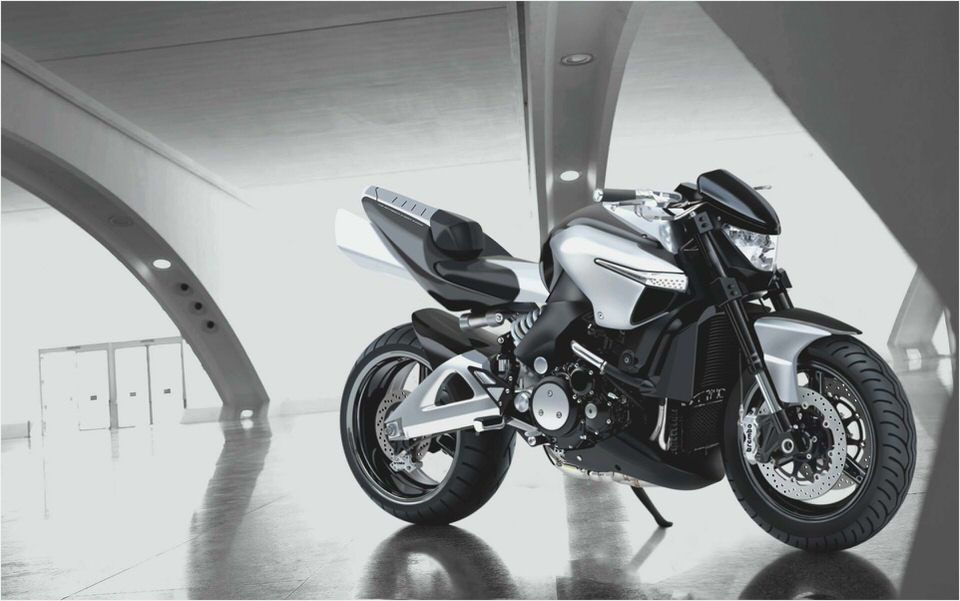
Displacement: 1340cc
Bore x stroke: 61.0 x 65.0mm
Compression ratio: 12.5:1
Induction: SDTV, 44mm throttle bodies, 2 injectors/cyl.
Transmission: 6-speed
Front suspension: 43mm KYB inverted fork, 4.7 in. travel; adjustments for spring preload, rebound and compression damping
Rear suspension: Single shock absorber, 5.4 in. travel; adjustments for spring preload, rebound and compression damping
Front wheel: 3.50 x 17 in. cast-aluminum alloy
Rear wheel: 6.00 x 17 in. cast-aluminum alloy
Front tire: 120/70ZR-17 Dunlop Sportmax Qualifier
Rear tire: 200/50ZR-17 Dunlop Sportmax Qualifier
Rake/trail: 25.5 deg/4.2 in. (107mm)
Wheelbase: 60.0 in. (1525mm)
Seat height: 31.7 in. (805mm)
Fuel capacity: 4.4 gal (16.5L); 4.2 gal (16.0L) California version
Weight: 578 lb (262kg) wet; 551 lb (250kg) dry (49-state version)
PERFORMANCE
Roll-ons: 60-80 mph: 2.96 sec; 80-100 mph: 3.42 sec
Quarter-mile: 9.84 sec @ 140.4 mph
Top speed: NA
Fuel consumption: 30-34 mpg, 33 mpg avg.
**’08 Suzuki B-King Opinions
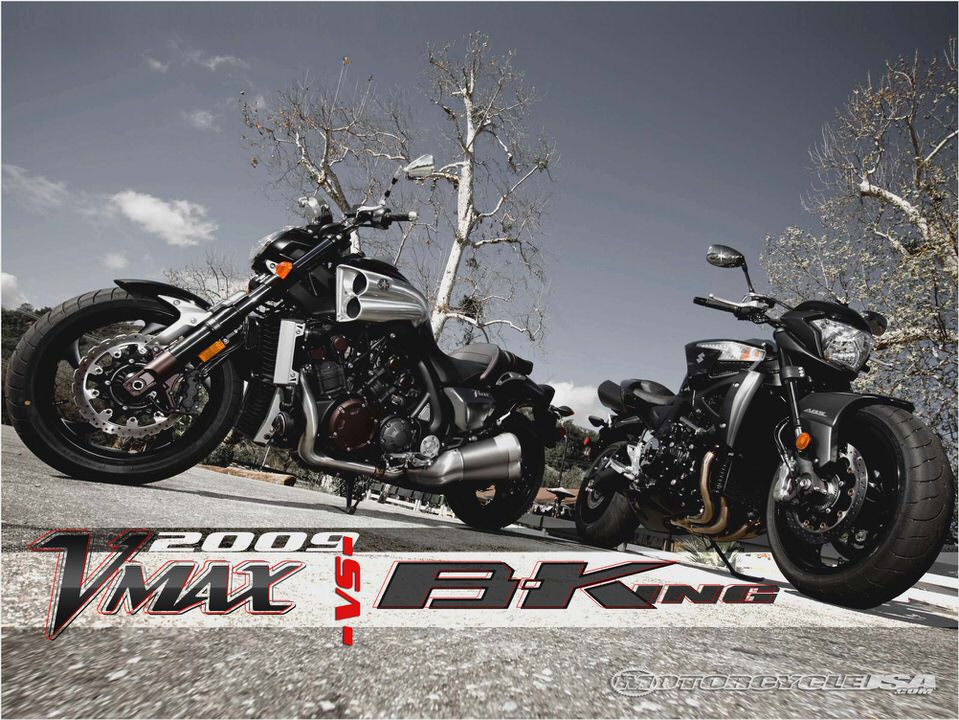
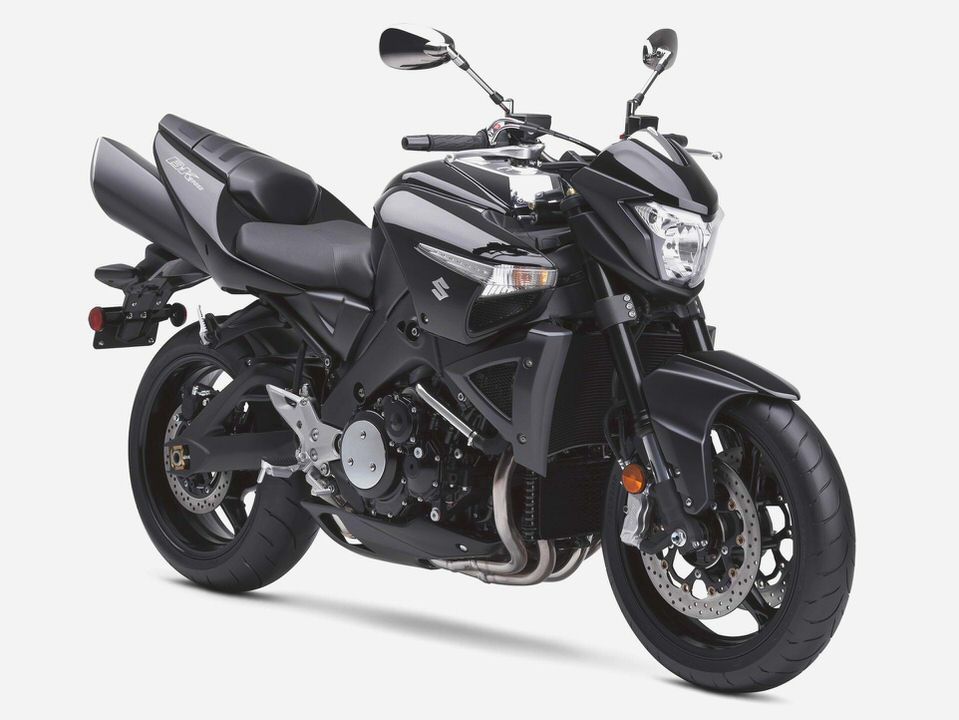
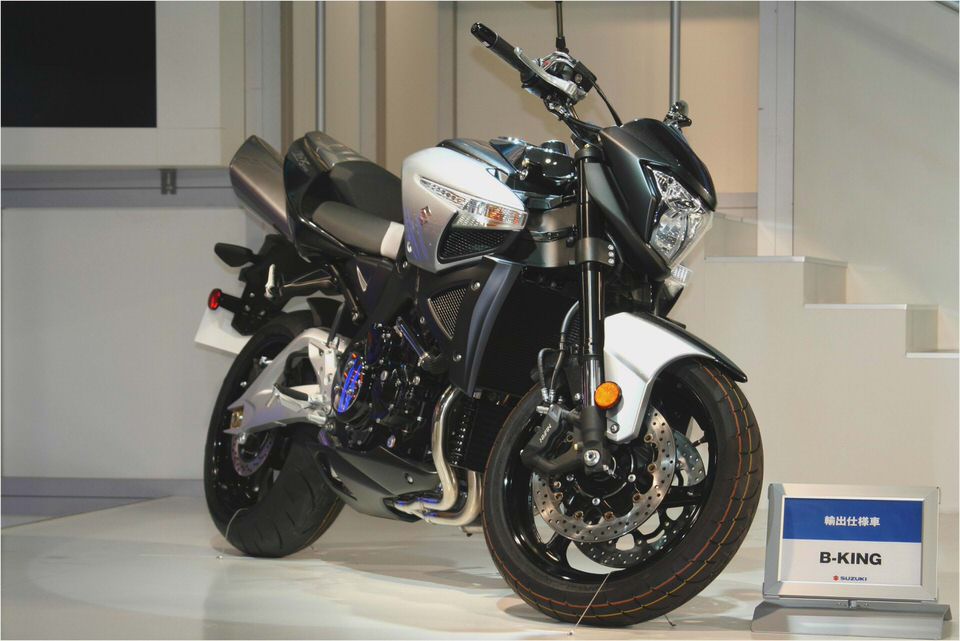
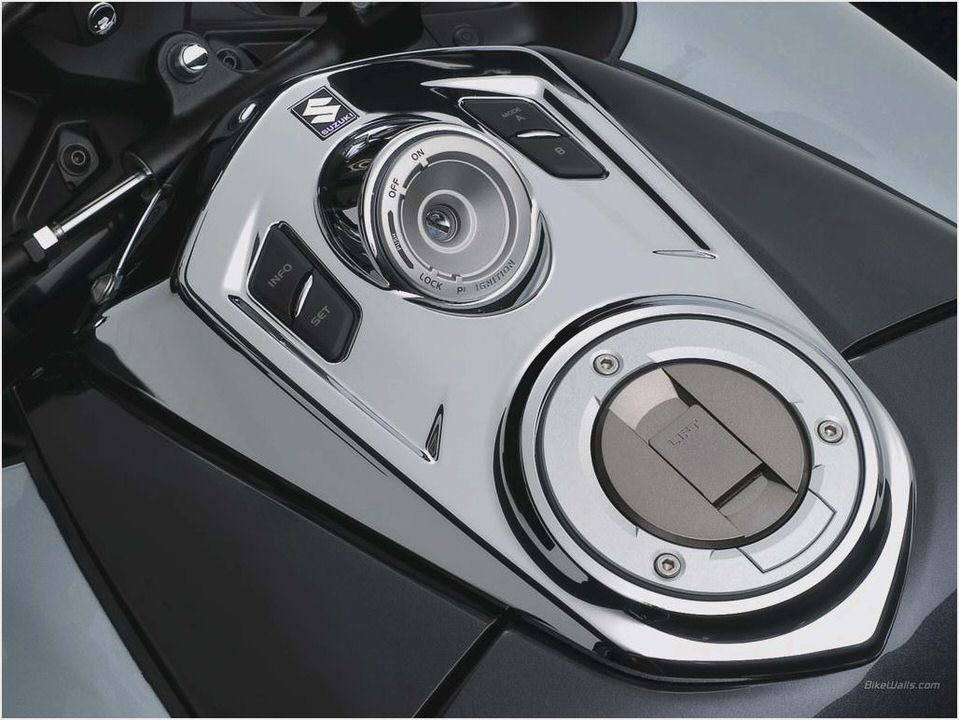
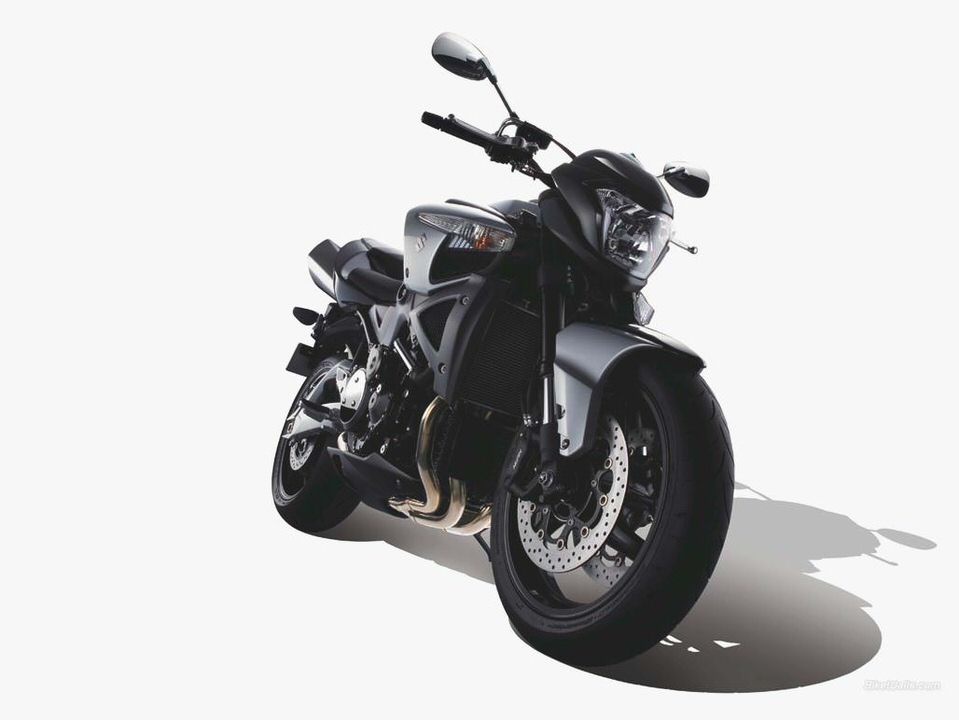
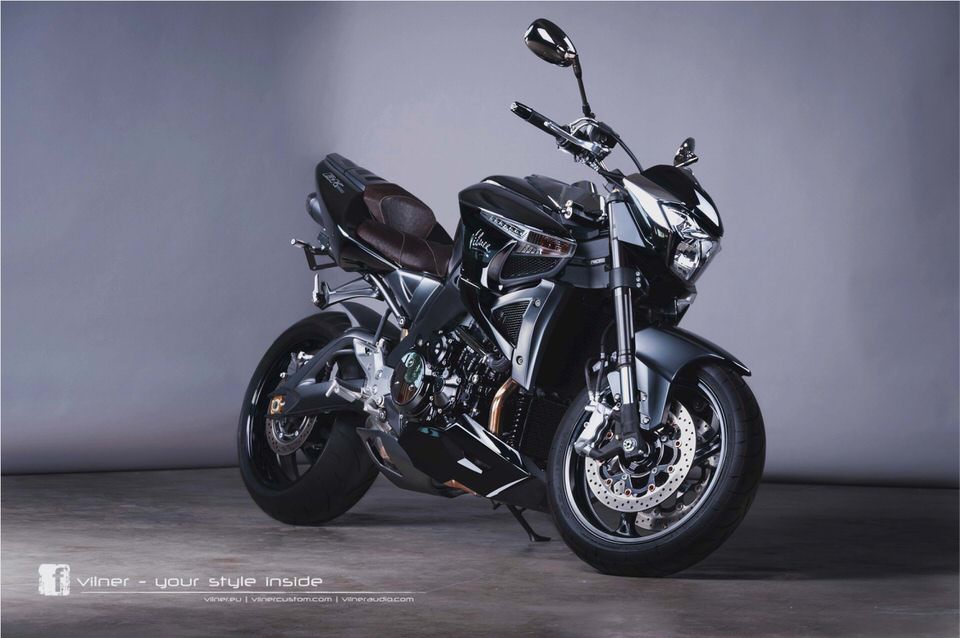
- Suzuki Boulevard C109R Cruiser – Motorcyclist Magazine Online
- Suzuki TC125, TS185, TM400, TM250, etc. Repair Manual 1964-1981
- Suzuki GSX-R History – CycleChaos
- Suzuki Burgman 400 – Owner Reviews Motor Scooter Guide
- 2014 Suzuki GSX-R 750 Review Unchanged & Razor Sharp
